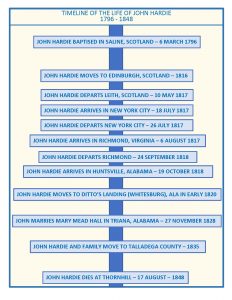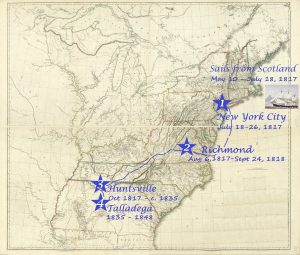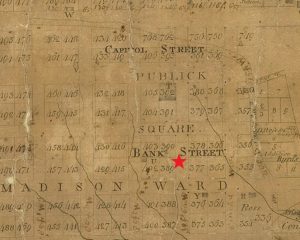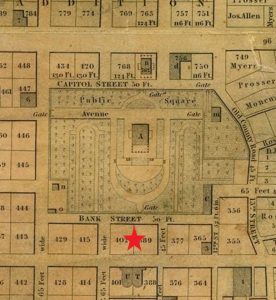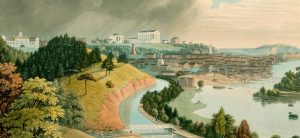….. and other Hardie-related information in Richmond
JOHN HARDIE’S TIMELINE AND MAP OF HIS AMERICAN JOURNEY
TIMELINE OF JOHN HARDIE – click on image to enlarge
JOHN HARDIE’S ROUTE FROM NEW YORK TO HUNTSVILLE
JOHN HARDIE IN RICHMOND – FROM 1817 – 1818
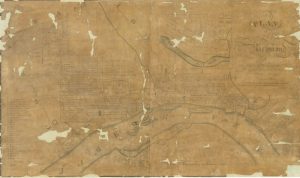 Plan of the City of Richmond by William James Bennett – 1809/1810 – from Library of Virginia – click on image for link to map on Library website
Plan of the City of Richmond by William James Bennett – 1809/1810 – from Library of Virginia – click on image for link to map on Library website
Location of “Post Office” next door to John Hardie’s place of work – directly across from Virginia State Capitol on 1809/1810 Map – Click on map for image
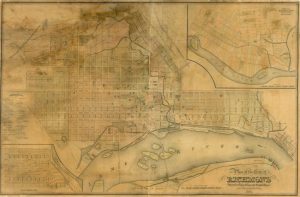 Plan of the City of Richmond – by Micahah Bates – 1835 – from Library of Virginia – click on image for link to map on Library website
Plan of the City of Richmond – by Micahah Bates – 1835 – from Library of Virginia – click on image for link to map on Library website
Location of “Post Office” next door to John Hardie’s place of work directly across from State Capitol on 1835 Map – click on map for image
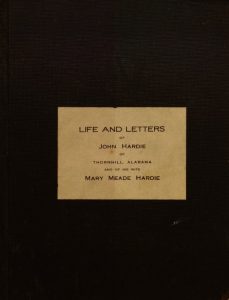 Life and Letters of John Hardie – Richmond Letters – Click on image for PDF of transcripts – Source: The Historic New Orleans Collection, gift of The Thornhill Foundation
Life and Letters of John Hardie – Richmond Letters – Click on image for PDF of transcripts – Source: The Historic New Orleans Collection, gift of The Thornhill Foundation
City of Richmond Virginia from the Hill Above the Waterworks by William James Bennett – 1834 – from Library of Virginia – click on image for link to image on Library website
“JOHN MOVES TO RICHMOND”
Excerpt from “John Hardie of Thornhill and His Family” by Lillian Galt Martin
click here to view
JOHN WORKS FOR SAMUEL MYERS, JR.
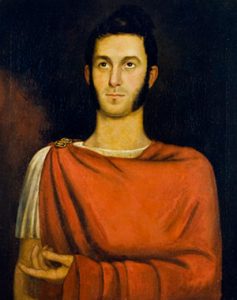 Sam – perhaps “Samuel Myers, Jr” (1790 – 1829) – from The Chrysler Museum – click on image for link to Myer family info
Sam – perhaps “Samuel Myers, Jr” (1790 – 1829) – from The Chrysler Museum – click on image for link to Myer family info
Advertisements in the Richmond Commercial Compile – July 10, 1817 and December 2, 1817 – click on image for larger image
When John Hardie moved to Richmond from New York, he had made arrangements through connections in New York to work in the “Counting House” of Mr. Samuel Myers, Jr. John worked there briefly, then worked for Myers’ uncle at a “grocery store”, and finally moved on to work for a Mr. Muir. The Myers family was a very prosperous and influential family based in Norfolk, Virginia. Their home, the Moses Myers House, is part of the Chrysler Museum in Norfolk, Virginia. The image above is one of several Sam or Samuel Myers in this extended family which had branches based not only in Norfolk, but New York City and Newport Rhode Island. The dates of John Hardie’s time in Richmond working for Samuel Myers, Jr. coincide with Sam Myers’ time in Richmond, so it is thought that they are one in the same. No information has been found on Mr. Muir – yet……
WHERE WAS THE POST OFFICE IN 1817/1818 & WHY DOES THAT MATTER?
In his letter to his brother in Scotland dated 3rd November, 1817, John Hardie scolds his brother once again for not writing. As John notes, if his brother has written him, he surely would get the letter because “Our counting house is next door to the post office”. So if the location of the Richmond post office in 1817 can be determined, we will know more or less the location of the counting house in which John worked. It took a bit of research, perusal of a few maps (see some above) and a few emails to those in the know in Richmond and elsewhere in Virginia. The final key to the puzzle was in an email from the reference coordinator at the Virginia Historical Society. He wrote:
In 1810, according to Bernard J. Henley’s article, “A Richmond Clerk Invented the Post Office Box,” in The Richmond Literature and History Quarterly (Winter 1979), page 38, the post office was merely a room in postmaster Dr. William Foushee’s home. Harry Kollatz, Jr. in “Checking Up on the Doctor,” Richmond Magazine (July 1, 2014), notes Foushee lived, from the 1780s until his death in 1824, at what’s now “the site of the 1936 Parcel Post building/Fourth U.S. Circuit Court of Appeals annex.” That is the Lewis F. Powell Jr. United States Courthouse, also known as the “U.S. Post Office and Customhouse,” located at 1100 E Main Street in Richmond.
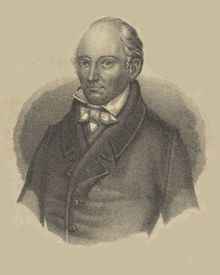 Dr. William Foushee – click on image to access articles about Dr. Foushee
Dr. William Foushee – click on image to access articles about Dr. Foushee
So who was this Dr. William Foushee (pronounced foo-shay)? Turns out he was quite the interesting fellow, and was involved in numerous early activities beyond being appointed as postmaster of Richmond by Thomas Jefferson. One can learn a good bit about an era in history by reading about the people who lived during that time. Click on the portrait above to access several short articles on Dr. Foushee.
WHERE DID JOHN HARDIE ATTEND CHURCH WHEN HE LIVED IN RICHMOND?
A tale of two religious denominations and a great tragedy
In his letters home to his brother, John writes, “Almost every Sunday at the Presbyterian Church, both of us sit in the same seat which belongs to Mr. Bridges; this is the Church I generally attend although at times I go to the Episcopal but very seldom, the minister of the Presbyterian Church is no great orator, but is a very serious and I believe a very good man, the ministers in this place I think upon the whole are inferior to those with you, although [sic] there is some middling clever men among them and shall I tell you that a Dr. Buchanan of the Episcopal Church an old unmarried Scotchman is thought the best preacher of the whole, a great many of our countrymen hear him.
From about 1800 to 1811, Episcopalians and Presbyterians in Richmond experienced a unique arrangement. The Episcopal priest, John Buchanan and the Presbyterian minister, John Dubarrow Blair alternated conducting ecumenical services in the Virginia State Capitol.
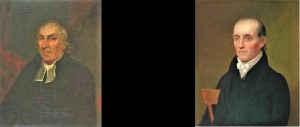
Reverend John Buchanan (Episcopal) and John D. Blair (Presbyterian) – source Encyclopedia Virginia
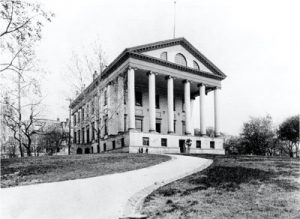
VIRGINIA STATE CAPITOL (before additions) – source Valentine Museum
This ended after one of Richmond’s greatest tragedies. On the night after Christmas, 1811, a tragic fire consumed the packed Richmond Theater and killed 72 people including men, women and children. Victims of the fire were buried in a common grave in the theater pit and soon after it was decided to build a church on the site of the theater as a memorial to that tragic event. Completed in 1814, it became Monumental Episcopal Church, since the majority of those who contributed to the building of this monument were Episcopalians.
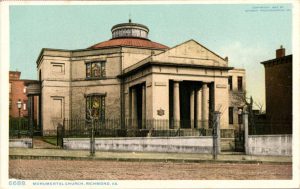
MONUMENTAL EPISCOPAL CHURCH – RICHMOND, VA – source Wikimedia Commons
Presbyterians continued to hold services until about 1812 when Dr. John Holt Rice came to the city. The “Pineapple” Church as the Presbyterian Church was known was completed in 1816 and eventually became First Presbyterian.
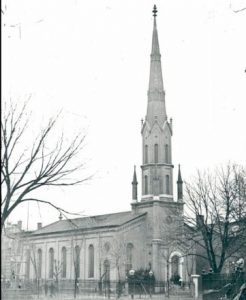
FIRST PRESBYTERIAN CHURCH – SECOND BUILDING CIRCA 1853 – source fpcrichmond.org
That is a fairly brief synopsis of where John Hardie attended church in Richmond. The tale of these two denominations and the tragic fire are far more detailed and multi-faceted. For those interested in more information.the book, “Historic Richmond Churches & Synagogues” by Walter S. Griggs Jr. is recommended.
In general, John did not seem impressed with the religious nature of Americans. In another letter to his brother, he writes:
“…I can assure you this is a vile land, in fact the people here in general seem to walk as if there were no God who seeth [sic] and heareth all things.”
HARDIE FAMILY-RELATED RICHMOND CONNECTIONS
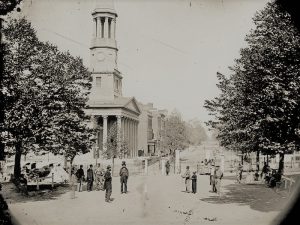 Richmond, Virginia with St. Paul’s Episcopal Church – Stereoscopic View – 1865 – Source: Library of Congress – click on image for link
Richmond, Virginia with St. Paul’s Episcopal Church – Stereoscopic View – 1865 – Source: Library of Congress – click on image for link
The Hardie family connection to St. Paul’s Episcopal Church – Our founder, Anna Meade Minnigerode’s husband Gordon Minnigerode was the great-grandson of Charles Frederick Ernest Minnigerode, rector at St. Paul’s for thirty-four years. Charles Minnigerode is credited with introducing the German tradition of the Christmas Tree to America while living in Williamsburg, VA, and was Rector of St. Paul’s during the Civil War, a close confidant of Jefferson Davis. We include the offering of a tour of St. Paul’s on Sunday after service. – Thanks to Susan Gwinn Goetze, Anna and Gordon’s niece for sharing information about this interesting family connection to Richmond.
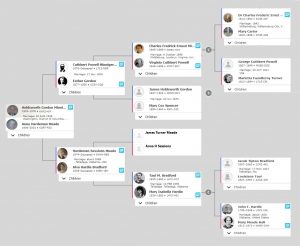 HARDIE-MINNIGERODE TREE – click on tree for larger image
HARDIE-MINNIGERODE TREE – click on tree for larger image
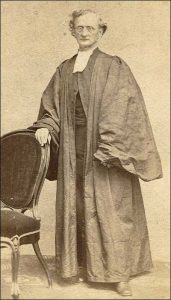 Click here to read “The Minnigerode” by Bill Izard about Charles Minnigerode
Click here to read “The Minnigerode” by Bill Izard about Charles Minnigerode
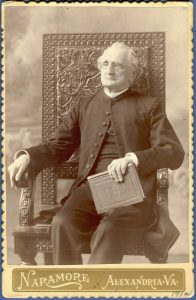
Click here to read about Charles Minnigerode in Encyclopedia Virginia
Click here to read “Christmas Trees, the Confederacy, and Colonial Williamsburg”
An additional tidbit for those Hardies raised in Alabama who paid attention in history class – the son of Charles Minnigerode, also named Charles Minnigerode, was aide to Confederate General Fitzhugh Lee during the Civil War and happened to be one of two men who carried the mortally wounded “Gallant John Pelham” off the field of battle.

